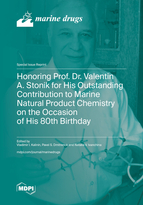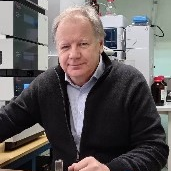Honoring Prof. Dr. Valentin A. Stonik for His Outstanding Contribution to Marine Natural Product Chemistry on the Occasion of His 80th Birthday
A special issue of Marine Drugs (ISSN 1660-3397).
Deadline for manuscript submissions: closed (30 November 2023) | Viewed by 23570
Special Issue Editors
Interests: marine natural product chemistry; secondary metabolites; sea cucumber triterpene glycosides; biological activities; evolution of biosynthesis; chemotaxonomy
Special Issues, Collections and Topics in MDPI journals
Interests: marine natural products; mass spectrometry; chemical structures; metabolomics; proteomics
Special Issues, Collections and Topics in MDPI journals
Interests: marine natural product chemistry; secondary metabolites; starfish polar steroids and lipids; biological activities; metabolomics; biosynthesis
Special Issues, Collections and Topics in MDPI journals
Special Issue Information
Dear Colleagues,
Intensive studies of marine natural products began in the 1960s. Marine metabolites show a great structural diversity, which indicates their unusual biosynthesis pathways. In addition, these compounds are fascinating to study as modulators of chemical–ecological interactions and possible active ingredients in medicinal and other useful preparations, such as taxonomic and food markers.
Professor, Dr.Sc. Valentin A. Stonik is one of the pioneers in this field, and began his impressive research career in marine natural products in the early 1970s, sometimes studying higher terrestrial plants and has continued his research activities ever since. He was born in Vladivostok, Russia on December 4, 1942 and graduated from the Department of Chemistry of the Far Eastern State University (Vladivostok) in 1965. Valentin A. Stonik received his PhD degree in Organic Chemistry in 1969 and Dr.Sc. degree in Bioorganic Chemistry: Chemistry of Natural and Physiologically Active Compounds in 1988. He became a Corresponding Member of the Russian Academy of Sciences in 1997 and a Full Member of the Russian Academy of Sciences (Academician) in 2003. He started his scientific activities from the synthesis of hydroacrydines and relative compounds. Since 1970, he has worked in the G.B. Elyakov Pacific Institute of Bioorganic Chemistry, Far Eastern Branch of the Russian Academy of Sciences. Prof. Stonik became Head of the Laboratory of Biosynthesis in 1976, Head of the Laboratory of Chemistry of Marine Natural Products in 1985, Deputy Director of the Institute from 1990 to 2002 and Director from 2002 to 2017. Since 2018, he has been the Scientific Advisor of the Institute.
His general interests in this research field are the structure and properties of biological active natural compounds from marine invertebrates, especially echinoderms and sponges, and his specific interests include the regulation of secondary metabolism, structural studies of alkaloids, unusual lipids, isoprenoids, polyhydroxysteroids, glycosides of polyhydroxysteroids, steroid and triterpenoid oligoglycosides, carbohydrates and other groups of natural products, as well as the investigation of the biological activities, biosynthesis, chemotaxonomy and chemical evolution of secondary metabolites. From the 1970s to 1990s he led numerous scientific expeditions on the research vessels “Kallisto”, “Professor Bogorov”, and “Akademic Oparin” in different regions of the Pacific and Indian Oceans. He is author and co-author of around 500 scientific articles in Russian and international journals, 3 monographs, 1 textbook and 20 patents. He is a member of the editorial boards of the journals: Marine Drugs, Natural Product Communications, Natural Product Letters, Russian Journal of Bioorganic Chemistry, and others.
On the occasion of Professor Valentin Stonik’s 80th birthday in December 2022, Dr. Vladimir I. Kalinin, Dr. Natalia V. Ivanchina, and Dr. Pavel S. Dmitrenok are editing a Themed Issue entitled “Honoring Prof. Dr. Valentin A. Stonik for His Outstanding Contribution to Marine Natural Product Chemistry on the Occasion of His 80th Birthday”, in order to congratulate their scientific mentor.
Contributions to this Themed Issue may be submitted as original research or review articles and cover every aspect of marine natural products chemistry, from studying the chemical structures of new metabolites of marine macro- and microorganisms to the investigation of their biological activities, chemo-ecological issues, biosynthesis, genetic research, applications of spectral methods, including NMR spectroscopy and mass-spectrometry, and the synthesis of biological active natural products and their analogs.
This Themed Issue is intended as a gift to Professor Valentin A. Stonik from colleagues, friends, and world experts in marine natural products chemistry and other related disciplines that are thriving in the G.B. Elyakov Pacific Institute of Bioorganic Chemistry under his supervision.
Dr. Vladimir I. Kalinin
Dr. Pavel S. Dmitrenok
Dr. Natalia V. Ivanchina
Guest Editors
Manuscript Submission Information
Manuscripts should be submitted online at www.mdpi.com by registering and logging in to this website. Once you are registered, click here to go to the submission form. Manuscripts can be submitted until the deadline. All submissions that pass pre-check are peer-reviewed. Accepted papers will be published continuously in the journal (as soon as accepted) and will be listed together on the special issue website. Research articles, review articles as well as short communications are invited. For planned papers, a title and short abstract (about 100 words) can be sent to the Editorial Office for announcement on this website.
Submitted manuscripts should not have been published previously, nor be under consideration for publication elsewhere (except conference proceedings papers). All manuscripts are thoroughly refereed through a single-blind peer-review process. A guide for authors and other relevant information for submission of manuscripts is available on the Instructions for Authors page. Marine Drugs is an international peer-reviewed open access monthly journal published by MDPI.
Please visit the Instructions for Authors page before submitting a manuscript. The Article Processing Charge (APC) for publication in this open access journal is 2900 CHF (Swiss Francs). Submitted papers should be well formatted and use good English. Authors may use MDPI's English editing service prior to publication or during author revisions.









